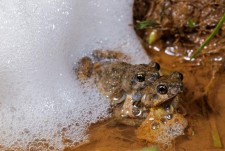 Tungara frog courtesy of National Geographic
Tungara frog courtesy of National Geographic
In yet another cool discovery using nature as a muse, scientists from Liverpool, England have found that a foamy cocktail whipped up by Trinidadian frogs during mating may serve as a mode of antibiotic delivery to potentially prevent infections.
Researchers from the University of Strathclyde recently presented their findings at the Microbiology Society’s Annual Conference, regarding the mating of Tungara frogs (Engystomops pustulosus). These tiny frogs, which measure less than five centimeters long, are native to Central America. As they mate they release a protein cocktail that they beat with their hind legs into a foam, and into which they release their eggs. These foamy cradles serve to protect their future offspring from disease, predators and environmental stresses.
Aside from nature, foams have clinical applications as well. Using foams as a vehicle for drug delivery is not a novel concept. In fact, they have been around for over three decades as applicators for topical medicine. Interestingly, there has been a growing market for using foams as a mode of drug delivery for several reasons – chiefly that there is a cosmetic appeal.
Consumers have displayed a preference for foams over other conventional topical treatments such as gels, creams and ointments. In contrast to its alternatives, foams are preferred due to their ease of application, uniform spreading, lack of stickiness and lack of greasy feeling and appearance. Additionally, with sensitive skin conditions caused by a sunburn or eczema, foams spread more quickly and require less rubbing to disperse. Foams have also been shown to increase compliance in patients.
Studies looking at steroids, antibiotics and antifungals have shown that foams have a superior capacity to deliver greater amounts of medication compared to creams, lotions or gels. Out-performance of foams over creams and lotions has to do with engineering and knowing which agents to incorporate for increased efficiency in drug delivery.
“Foams are usually very short-lived so they’re not considered for long-term drug release, even though they have great potential for topical treatments,” said Sarah Bozio, from the University of Strathclyde, one of the researchers in this study. “This foam comes from a tiny frog and yet offers us a whole new approach that could prevent wound infections, and with increasing antibiotic resistance it’s important that all new tactics are explored.”
What sets the frog foam apart is that it has been found to be highly stable and capable of sustained release of a drug at a stable rate. Vancomycin, an antibiotic that is used to treat methicillin-resistant Staphylococcal aureus (MRSA), when loaded into the foam was able to prevent bacterial growth for up to 48 hours.
The scientists have been able to clone two key active proteins found in the frog foam and they are working toward a synthetic version of it. The clinical applications would be invaluable in the treatment of severe burns which are exceedingly vulnerable to infection. The other appealing feature of frog foam is its lack of toxicity to human cells.
The study’s lead researcher, Dr. Paul Hoskisson, stated, “Foams are unusual in nature and are typically made of inactivated proteins, yet this foam is stable and importantly compatible with human cells, making it potentially ideal for pharmaceutical applications. While foams like these are a long way from hitting the clinic, they could help in burns and wound treatment, providing support and protection for healing tissue and delivering drugs at the same time – all from a humble little frog.”



